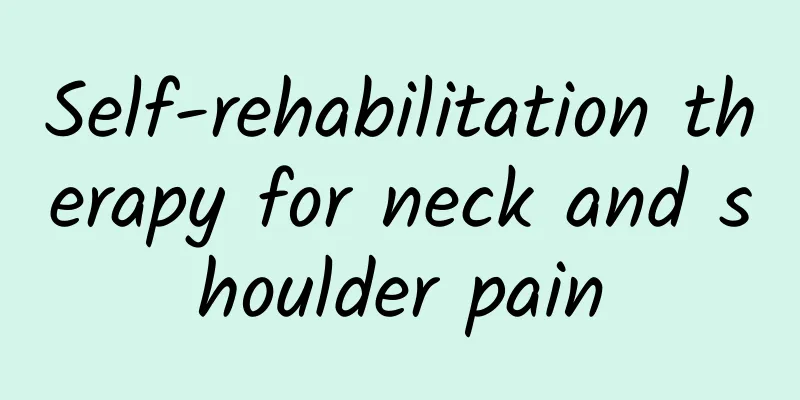Self-rehabilitation therapy for neck and shoulder pain

|
Neck and shoulder pain is a common pain problem, with an incidence rate of almost 100% in the population, which means that everyone may experience neck and shoulder pain in their lifetime. The pain mainly occurs in the back of the neck, the neck-shoulder connection area, the two shoulder blades, and the area between the shoulder blades. The pain can sometimes radiate to the head, trunk, and upper limbs. Causes of Neck and Shoulder Pain 1. Bad habits and postures: working at a desk or using a smartphone for a long time, reading in bed, bad sitting and sleeping postures, inappropriate pillow height, etc. Tense neck muscles are difficult to relax, which destroys the balance between muscles over a long period of time, reduces muscle strength and endurance, and when some movements are needed, this weak link is easy to collapse, resulting in symptoms such as pain. 2. Degeneration of the bones and joints in the neck and shoulders: With age, the cervical spine and shoulder joints gradually degenerate, the articular cartilage wears out, and improper joint movement can easily cause pain. 3. Nerve compression: Bone hyperplasia or disc herniation in the cervical spine can compress the spinal nerves, causing symptoms such as pain, numbness, and weakness. 4. Trauma: Damage to bones, joints and surrounding tissues caused by direct or indirect violence to the neck and shoulders, and chronic pain left after treatment. 5. Chronic diseases: such as rheumatoid arthritis, rheumatoid arthritis, malignant tumors, etc. can also cause neck and shoulder pain. Introducing several self-healing treatment methods Cervical spine range of motion exercises 1. Flexion and extension exercise: Sit or stand, lower your head, bring your chin close to your chest, then straighten it back, and then slowly raise your head. Repeat 10 times. 2. Left-right rotation exercise: Sit or stand, keep the cervical spine in a neutral position, first rotate to the right as far as possible, do not shrug your shoulders, then return to the normal position, and then rotate your head to the left, imagining that you are drawing a circle with the tip of your nose with the cervical spine as the axis. Repeat 10 times. 3. Lateral flexion exercise: Sit or stand, first tilt your head to the right, bring your ears close to your shoulders, keep your shoulders down, and don't shrug. Then return to the normal position and tilt your head to the left. Repeat 10 times. Neck muscle strength training 1. Activation of deep cervical flexors: ① Jaw retraction training Starting position: Sit or stand with your fingers on your chin. Action: With your eyes facing forward, gently push your chin back toward your throat, feeling the stretch in the back of your neck. Hold for 5 seconds, then slowly return to the starting position. Repeat 10 times per set, 1-2 sets per day. ② Four-point support and resistance jaw retraction exercise Starting position: Four-point support position, support with hands and knees, hands as wide as shoulders, legs as wide as pelvis. The top of the head is one yoga ball away from the wall, and then fix the yoga ball between the top of the head and the wall. Action: Slowly tighten your jaw to bring your cervical spine into a neutral position, and imagine the top of your head extending toward the extension of your spine. Hold for 2 seconds at the end, then slowly return to the starting position in 4 seconds. Repeat 10-15 times per set, 1-2 sets/day, 3-5 days a week.
First, press the fascia ball on the painful point, then lean against the wall and press the fascia ball between the body and the wall. You can move it slowly up and down, left and right. The time is 1 minute, and the intensity should be tolerable. Foam roller to relax the chest and back: Starting position: Sit down, slowly lie down, press your back (shoulder blade level) on the foam roller, support yourself with your feet, and slowly lift your hips. Use your legs to roll your back up and down on the foam roller for 1 minute. If you feel obvious pain, you can reduce the rolling amplitude and time. Stretch and relax the sternocleidomastoid muscle: Sit or stand and find the point where the muscle attaches to the right side of your clavicle. Place three fingers 2.5 cm from the base of the muscle and place your left hand over the fingers of your right hand. Action: Slowly move your head backward and to the left until you feel a slight stretch on the right side of your neck. Stretch for 5-10 seconds. Repeat 2-3 times. Pectoralis major stretch: Starting position: Stand with your right hand and forearm against the door frame. Your elbow should be slightly higher than your shoulder. Tighten your abs to avoid arching your back. Step forward with your right foot. Action: Slowly bend your right leg, with your center of gravity forward and downward. Stretch for 5-10 seconds until you feel a slight tingling sensation in your chest muscles. Repeat 2-3 times. Trapezius stretch: Starting position: Sit on a chair with your feet a certain distance apart and your back and abdomen slightly tightened. Reach your right hand behind you and grab the edge of the chair. Lean your upper body to the left, keeping your head upright. You will feel a slight pull on your right shoulder or upper arm. Action: Lean your head to the left and slightly turn it to the right. Use your left hand to support your head and carefully pull it to the left. Stretch for 5-10 seconds. You will feel a slight tingling in your neck and shoulders. Repeat 2-3 times.
|
<<: It has nothing to do with romance. Do you really understand rosacea?
>>: What you think is “fat” may not be fat, and what you think is “not fat” may be really fat…
Recommend
How long is the recommended walking time during pregnancy?
Many women should also pay attention to proper ex...
Risks after endometrial ablation
There are many dangers after endometrial ablation...
What to do if breasts are not developed?
During puberty, breast development is critical, a...
Which is less harmful, medical abortion or surgical abortion? Understand it clearly before choosing
If a couple does not take any contraceptive measu...
How effective is Gongyanping in treating cervicitis?
Cervicitis is a very common gynecological disease...
Popular Science | What are the dangers of not promptly repairing missing teeth?
Many people think that missing teeth are not a bi...
What causes numbness in female tongue?
In daily life, I believe that many people will ex...
Does the amount of milk have anything to do with eating?
During the breastfeeding period, every day become...
What to do if a girl has irregular menstruation
For adult women, occasional irregular menstruatio...
Can I have sex before and after my period?
You can have sex during menstruation, but there i...
Will taking the medicine to get menstruation lead to ovulation?
Menstrual abnormalities are very common in life. ...
Bleeding with blood clots during pregnancy
Pregnancy is a very important thing for women. It...
What are the benefits of drinking red wine at night?
Women need maintenance, otherwise they will age v...
What are the physical symptoms before your period?
Menstruation is women's menstruation, which i...
Do your eyes become dry after using the computer for a long time? Quickly "rehydrate" your eyes! Understanding dry eye syndrome
Dry eye syndrome is a general term for a variety ...









